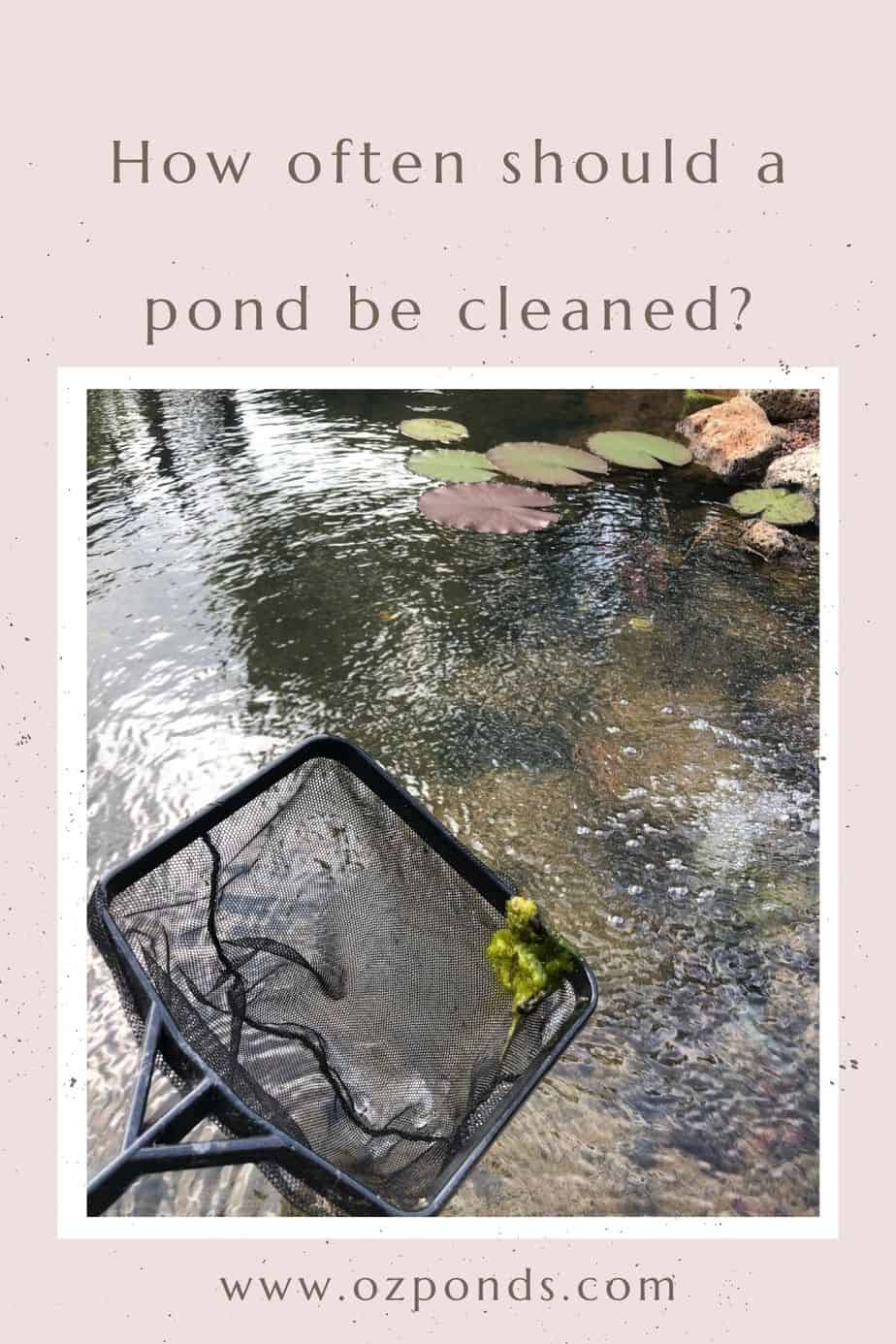A pond should be cleaned as little as possible. Ponds are a very unique ecosystem.
They rely on nitrifying bacteria to purify the water. If the environment is “too clean” it can actually become unsafe for fish and other aquatic creatures.
You can by all means do minor tidy ups but a full scale empty and clean should be avoided if possible.
The best way to clean a pond is a little bit here and a little bit there.
The pond filters will need to be cleaned more often.
Pond filters are not created equal!
Some are just a pain in the bum, others will make pond ownership a breeze.
I have an article on pond filters which will help you make the best choice for your pond.
It is possible to create a pond environment that will never need a full scale clean out.
Tips to creating an easy to maintain pond
1. Not too many fish
Fish add what’s called a bio load on the pond. Basically they produce waste!
That waste needs to be removed somehow. Some is consumed by nitrifying bacteria, some is removed by the ponds filter and if that’s not enough some needs to be removed by you.
So keep that in mind. More fish more muck!
I have an article discussing some general guidelines when it comes to how many fish you can keep in a pond.
And the fish you do have don’t over feed them!
In fact they don’t even need you feeding them. So if you must once or twice a week will be plenty.
2. Build the pond up
One of the most common mistakes people make is digging the pond in an area that receives plenty of runoff.
This is ok for a farm dam or pond. But not for a nice clean, clear garden pond.
The problem with surface water is it picks up all the junk it moves over. Think lawn clippings, mulch, fertiliser, twigs, leaves, ect.
And all that ends up in the pond!
In the pond it starts to breakdown. This release nutrients into the water. Now you got algae everywhere.
The algae consumes oxygen in the pond. The system crashes. The algae dies. It sinks to the bottom.
Settles on all the other junk that’s in the bottom. Now you’ve got a thick layer of sludge.
The bacteria start to consume the sludge, that releases more nutrients. The algae comes back.
This cycle will keep repeating!
Eventually the pond becomes a bog.
If you inherited a pond like this. Add drainage around the perimeter or build a berm. You need to prevent surface water entering the pond.
3. Prevent debris from sinking to the bottom of the pond
Anything organic that falls into the pond will produce nutrients as it decomposes. This is a potential for algae growth and sludge build up.
If the pond is small enough you might be happy to scoop out the leaves, ect with a small net.
I’m a bit more lazy I don’t wanna do that every few hours!
So I like to create a pond skimmer or intake bay.
This is a type of filter that will suck in the majority of debris before it sinks to the bottom of the pond.
Here’s a video how they work.
The sponges or basket will need to be cleaned out from time to time. Mine I do once a week. Takes approximately two and a half minutes, give or take.
A skimmer or intake bay won’t get it all but trust me it will make a massive difference over the course of a season.
4. Provide homes for nitrifying bacteria
Nitrifying bacteria are the heart and soul of a pond ecosystem. Without them it doesn’t work!
The good news is they don’t ask for much.
All the bacteria need is real estate. Wet surfaces to be precise.
You can simply add rocks and gravel to your pond, this greatly increases the surface area available.
While this will help add nitrifying bacteria to the pond we also need them active in the filter.
I mentioned there are many different filters available. For me the best filters are the ones that provide the most area for the nitrifying bacteria.
More bacteria means less maintenance!
I install a bog filter on all my ponds. My preference is an up flow bog. This means the water is pushed up through the rocks and gravel that house the bacteria.
These systems are ridiculously maintenance free.
To learn more about bog or wetland filtration you can read my article by clicking the link.
All other filters will provide homes for the nitrifying bacteria, I just find them inadequate and expensive!
5. Add oxygen
As the bacteria work their magic, they consume oxygen. Therefore it’s important to ensure the pond is an oxygen rich environment.
There are many ways that oxygen can be added to the pond.
The most obvious choice is an aerator connected to some air stones.
You might prefer a waterfall, fountain or spitter.
Even just a surface jet pushing water across the surface of the pond will add oxygen.
Whatever appeals to you, your taste and budget.
6. Add plants
The fish produce ammonia. The nitrifying bacteria convert it to nitrite and then nitrate.
All these compounds are nitrogen. Plants love nitrogen!
It is in all common plant fertilisers.
Algae is a plant too.
So all that nitrate that is left over at the end of the nitrogen cycle needs to be consumed or removed.
There is two ways to remove or dilute nitrate. Either a water change or plenty of plants.
Adding plenty of plants will help consume that nitrate and outcompete the unsightly algae.
It’s a good idea to trim and thin out your pond plants as they grow, this will keep them very active and therefore very hungry.
I have a list of 40 awesome pond plants that will give you some ideas for your pond.
7. Stir up the pond frequently
Even with a skimmer or intake bay some things are still going to accumulate on the bottom of the pond.
The more often you can stir up the sediment at the bottom of the pond the better.
As it all gets tired up it will get pulled over to the skimmer, where it will become trapped in the filter sponges for cleaning at a later date.
To stir up the pond there are a few ways.
My favourite just get in the darn thing. In summer there’s nothing better than getting right in there.
As you thrash about and fall over you’ll be amazed how much debris gets suspended in the water.
The water will go quite cloudy but don’t disappear in a few hours it will be so clear and clean you’ll be jumping in every other day.
Another way to stir up those bottom sediments is adding water jets.
The aim here is to create a strong enough current that anything that sinks to the bottom is kicked right back up.
At the moment I am trialling using a solar pump to power some water jets. So far I’m quite happy with the results.
8. Do a spring clean but don’t get carried away!
So no matter how hard you try over autumn and winter the pond gets a little forgotten about. The leaves aren’t getting scooped out as often.
The pump and skimmer may be turned off.
You certainly aren’t getting in the pond to stir up the sediments.
So when spring comes along the chances are good that quite a lot of sediment has built up there on the bottom.
As the water warms up the bacteria bounce back into action, and that releases all those nutrients.
As soon as you can you want to turn the pump and skimmer back on. And physically scoop out as much sediment as you can.
It will be mostly leaves and algae. By removing these large objects we can allow the bacteria to focus on the small stuff.
You don’t need to get it all out in one day. The water will get all stirred up, just clean the filters and go again in a few days.
I usually find after 3 scoop outs I’ve got all the large solid stuff. No need to drain the water.
9. Add bacteria frequently
The bacteria have life cycle, they will re produce but they start getting lazy.
This isn’t necessary but you will notice a big difference.
There is no need to add them over the winter as they go dormant. But once the water temperature is over 10C (50f) its time to add them regularly.
Ive tried many brands of bacteria they are all pretty much the same, so just buy whatever is most cost effective for you.
I hope you found this article helpful.
Perhaps you would like to join my mailing list where I share discounts and special offers on pond related products. If so click the button below.
Thanks for reading.

